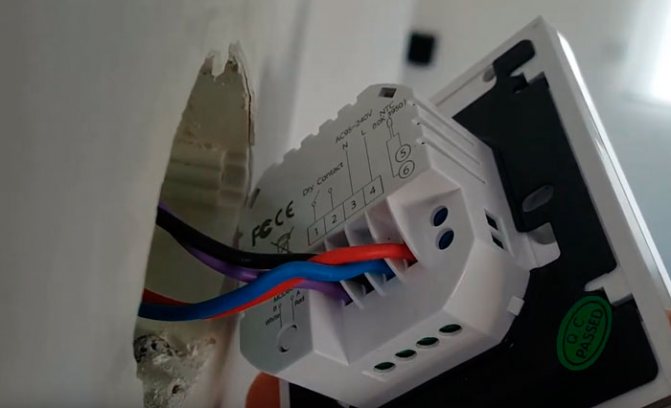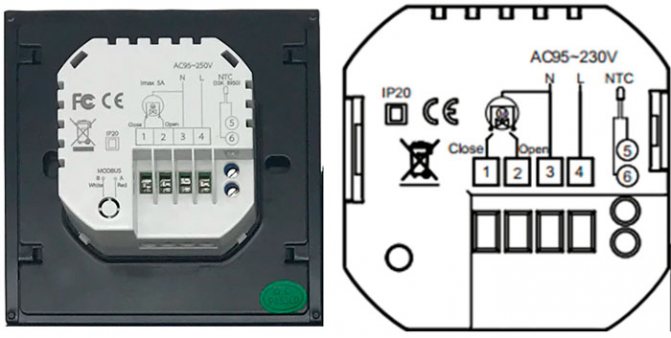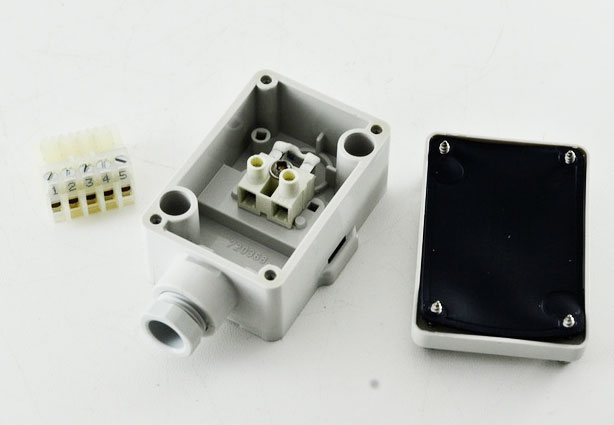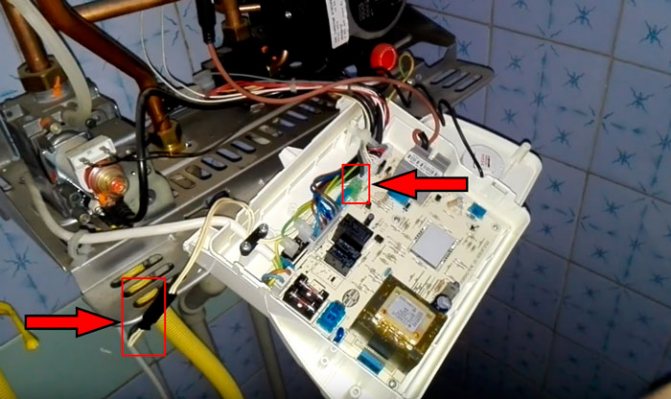Where and where to connect the wires on the gas boiler?
To connect the thermostat from the terminal block of the boiler to the Dry Contact contacts, you need to connect two conductors.

According to the instructions, the recommended cross-section of copper conductors is at least 0.75mm2.


The cable length to the place where the thermostat is installed must not exceed 50 meters.
Look for the necessary terminals on the boiler itself in the manufacturer's instructions, or be guided by the inscriptions on the blocks.
These terminals are most often located on the back of the control board.


However, sometimes manufacturers take them out of the board.


Some installers, during installation, connect a cable here and bring it out so that the consumer does not climb to the board in the future and does not confuse something there. Since the thermostat has not yet been installed, the cable ends are short-circuited.
By the way, be careful with this remote block. Some consumers faced the problem of factory wire entanglement, such as Protherm (Proterm).


As a result, everything started to work as it should, only with the reverse connection.


Initially, there is a jumper between the terminals. If the jumper is broken, the gas boiler will simply stop working.


When the thermostat is connected, the factory jumper is dismantled and a cable is put in its place, laid to the place where the thermostat is installed. Most importantly, you do not need to change any internal settings on the boiler.
A low voltage control pulse (usually 24V) is supplied through these contacts.
We have a control device (thermostat) and a slave (boiler). Between them, a set of requests-responses is constantly being transmitted over a low-current line.


The principle of operation here is simple - by closing the dry contact, we thereby enable the operation of the boiler, by opening it, we interrupt the data transmission and prohibit it. Closing and opening occurs through the thermostat relay, depending on the set temperature on the device and comparing the current indicators in the room.
When triggered, the burner is switched off first, then after a certain period (pump run-on time) and the circulation pump. Although in different models, the pump operation algorithm may differ.
One of the algorithm variants


It is not advisable for the pump to turn off immediately after the thermostat has tripped. In this case, set the overrun from 5 to 10 minutes in the menu. Then the entire heating system will cool down evenly and the time intervals for the automatic operation will increase.
On expensive models that support the OpenTherm protocol, a remote programmer can be used to control many of the built-in parameters of the boiler, and not just turn it on and off.
Here are illustrative examples of where to connect the thermostat for different boiler models:
BaxiBoschElectroluxVaillantJunkersBuderusViessmanFerroliAtronAlpha CalorImmergas
What happens if the thermostat fails? How will the boiler behave in this case?
It all depends on the position in which the dry contact remains. If closed, nothing bad will happen. The boiler will simply start operating according to its last preset program.
If open, the heating will not start and will not work.
Please note that the thermostat does not affect the operation of the burner in hot water mode.
The voltage of 220V is applied to the power contacts of the thermostat - phase and zero (L and N). This can be done either from a separate outlet or distribution box, or taken directly from the boiler itself.


On a regulator with dry contacts, it does not matter where to start the phase or zero, but on models for electric underfloor heating, this plays a significant role in the issue of operational safety.
Since if the connection is incorrect, only the neutral conductor will break, and the phase will constantly be on duty on the heating cable.
Mechanical or electronic thermostat
By the way, for a gas boiler, you can use another simpler type of regulator, which does not even have to be supplied with a voltage of 220V. For example, Termec Emmeti mechanical thermostat or other similar models.


Here is the "usual" Termec wiring diagram.


You only need to use normally closed contacts 1 and 3, completely eliminating the 220V change (L and N).


The built-in sensor will open and close the internal contact when the temperature in the room changes. He does not need any food. In this case, the entire logic of the heating operation is similar to that discussed earlier.
Just remember that almost all mechanical models have a very large hysteresis. You cannot create a comfortable room temperature with their help.


Therefore, whenever possible, choose electronic devices with a WiFi connection. Fortunately, in our time, the Chinese can find very decent and inexpensive options.
For example, such as this one (thousands of satisfied customers and positive reviews).


More details
Some models have contacts labeled NO (normally open), NC (normally closed), and COM (common). Someone advises to connect through them, namely through NC and COM.
However, be careful, the thermostat is the thermostat, and always read the instructions. Through them, an alternating voltage of 220V can also be supplied, and thereby you start a phase on the control board where you do not need it.
Here's a prime example of these multifunctional Fluoreon and Beok controls.


On multifunctional devices, the room temperature is also determined using the built-in temperature sensor.
However, they have terminals on the body for connecting and external (Sensor). It is most often used for underfloor heating.
Place of installation
As you know, the air temperature in a room with traditional heating systems on radiators warms up unevenly. It is lower near the floor, higher under the ceiling.
Based on the presence of a built-in temperature sensor in the thermostats, their installation height is regulated.


Such thermostats should be placed at a height of 1.2-1.5 m from the floor level and as far as possible from heating sources, including protected from direct sunlight.
It is also not recommended to put thermostats in the hallway or in the kitchen.
Connecting a floor heating thermostat to a gas boiler
Often consumers ask themselves the question, is it possible to use a standard thermostat from heated floors for 220V to work with a gas boiler?


Suddenly you did not find a special thermostat with dry contacts, and you already have a model for warm floors in stock. Such a connection is possible.
However, for this you need to “decouple” the 220V voltage. In most underfloor heating thermostats, it comes to the power terminals and then is removed from the terminals that go to the heating cable. And as mentioned above, when working with a gas boiler, “dry contacts” are used, through which low voltage pulses are transmitted.
If you directly connect the cable from the boiler control board here, you will provoke a short circuit and damage your boiler.


For a safe connection, an intermediate relay or an additional contactor with normally open contacts will have to be added to the circuit.
From the thermostat terminals, instead of the underfloor heating cable, apply 220V voltage to the relay (contactor) coil, and through its normally open contacts (1-2 or 3-4), connect the wires to the gas boiler.


The principle of operation is the same as discussed earlier. However, keep in mind the following feature.
Since this is a thermostat for warm floors, it will most likely work according to the following scheme: air sensor + floor sensor. This means that it will require you to install and set a temperature limit for a floor sensor, which you will not have.


Therefore, in the settings, you will have to untie the floor sensor and leave only the air sensor in operation. How to do this, read the instructions for your model in detail. Different devices may differ.
For example, in Devi Touch, for this you have to break a special jumper on the back side.


In order not to have all these difficulties and problems, it is better to choose the correct thermostat model from the beginning.
Water floor collector thermostat
If there is a water heated floor in some rooms, which can be powered from the same gas boiler, a slightly different type of thermostat is needed. It must be connected to the servos on the manifold.
The reverse side of such a device looks like this.


If your servo is normally closed, then the cable conductors are connected to terminals 1 (Close or NC) and 3 (N-zero or COM). If normally open - 2 (Open or NO) and 3 (N-zero or COM).
The principle of operation is as follows. When a normally open servo is installed in the system and there is an interruption in the supply voltage on the supply cable, the servo opens the duct. In normally closed, the situation is the opposite.
At the same time, do not be confused, this is not some kind of relay or electric magnetic drive, which, when a voltage of 220V is applied, flips and instantly switches to another state. It is a thermoelectric actuator that gradually opens and closes the valve.
Therefore, if you want to test the performance of such a device, do not be surprised that it will not immediately respond to a signal and immediately cut off the flow.
The thermostat power connection is carried out on the L and N strips. The cable for the remote temperature sensor in the floor is connected to the side terminals.
A source
Share the news on social networks
- Similar posts
- Torque screwdriver - overview wera, wiha, weidmuller. Torque.
- How to choose an RCD in 5 minutes
- Analogues of self-supporting insulated wire reinforcement - comparison tables Ensto, Niled, Sicame, VK, IEK, MTZA.
«Previous post
Adjustment


You need to check how the thermostat behaves. To do this, certain parameters are set on it, and see how the boiler reacts to the commands sent by the thermostat. If everything is in order, then you can make final adjustments. How to do this is described in the product passport.
Vilant group Slovakia, spol. s.r.o. Pplk. Plushtya, ...
Page 40
- Picture
- Text
Vilant group Slovakia, spol. s.r.o. Pplk. Plushtya, 45 909 01 Skalica Slovak Republic
www.protherm-ru.ru
Your service:
We reserve the right to make changes


Comments (1)
Highlight → I found instructions for my water heater here! #manualza
- Click →
The brain of each of us is like a miracle mechanism. Only the majority have instructions for it in Chinese.
Manualza! Manualza.ru
Still not with us?
Components for boilers Proterm Skat
When buying a boiler, in addition to it, the manufacturer offers various accessories to expand the functionality.
Thermostats
For Skat boilers, Proterm proposes to use three types of room regulators: Exabasic (article 6195), Exacontrol (article 0020159367) and Exacontrol 7 (article 0020170571).


Room thermostats for boilers Protherm Skat
The simplest model Exabasic has only a rotary switch for setting the temperature, the Exacontrol is already equipped with a display and has a mechanical control. Modification number 7 - has the function of weekly programming.


Wiring diagram of the thermostat to the Protherm Skat boiler
Temperature sensors
To adjust the operation of the boiler, relative to the temperature outside the window, you must purchase an outdoor temperature sensor (article 0020040797).


Outside temperature sensor for boilers Protherm SKAT
In the retail network, its cost varies around 2,000 rubles (38 euros).
Boiler installation Proterm Skat with a boiler
If you want to provide your home with hot water as well, then you need to purchase an indirect heating boiler. In order for the boiler to start working in conjunction with the boiler, you need to purchase a Fugas three-way valve kit (article 0020015570) for single-circuit boilers. A ready-made kit will cost 116 euros.


Connection kit fugas three-way valve to the boiler Proterm Skat


Diagram of connecting an electric boiler Proterm Skat to an indirect heating boiler
Room thermostat: what are the benefits of using it?
As promised in the last article, here I will talk about a device that is also called a thermostat, however, in my opinion, it would be more correct to call it room thermostat... Because, unlike those discussed in the previous article, he himself does not mix the coolant with the hot one, but controls other devices, including thermostatic valves.
What is a room thermostat for?
The thermostat allows you to make the operating mode of the heating system the most optimal, thereby significantly saving fuel and electricity, as well as the boiler resource: the boiler will not start when the rooms are already at a comfortable temperature.
Also: if you are not at home all day, then you can program, for example, from 8.00 in the morning to 17.00 in the evening to keep the temperature in the house less, for example, 15 degrees. The rest of the time, when you are at home, from 17.00 to 8.00, program the temperature higher.
With the thermostat, weekly programming can be done. This is convenient if the heating is somewhere in the country house, where they are only on weekends. Then you program on the regulator the time for the system to warm up to a comfortable temperature, say, from Friday evening to Monday morning, and by your arrival on Friday evening the house will become warm and cozy (well, this device does not go to the store, this is its minus ... :))
The principle of operation of room thermostats
The principle of operation of thermostats is quite simple: the contact closes / opens - that's it. And everything else is an external environment, which can be different, adding some programming possibilities, well, and, of course, cost.
Types of thermostats
There are many room thermostats produced, it will not be easy to list them all, I believe that manufacturers are not lazy and now and then throw new models onto the market. I will give just a few examples - to give an idea of how this device looks.
On the picture mechanical room thermostat :


Thermostat (thermostat) room mechanical
This is perhaps the simplest model. Here, the required temperature for a particular room is set by turning the wheel. When this temperature is reached, a contact is closed inside the thermostat, and the signal goes to the actuator, that is, the servo that opens / closes one or another valve.
The photo below shows another model of an electronic thermostat:


Electronic thermostat with display
Its principle of operation is exactly the same as that of a mechanical one. The only difference is that the set parameters are shown on the display.
Electronic thermostats are more accurate, their error is much smaller than that of mechanical ones.
Electronic thermostats are also different. There are more complex, programmable ones on which you can set daily or weekly adjustments.


Electronic thermostat programmable
Another electronic room thermostat - AURATON 2005 / AURATON 2005 TX RXPLUS:


This is a pretty perfect thing that allows you to set different modes for the heating system. The model shown in the photo above is connected to the boiler with a wire, but there is the same manufacturer, but wireless:


- consisting of an executive part, which is located next to the boiler, and a sensor located in the room, where it is necessary to maintain a certain temperature.
How to install a room thermostat?
The way the thermostat is connected depends on whether it is wired or wireless.
Sensor wired thermostat installed in a room where the temperature must be maintained, on the part of the wall where the sun's rays do not fall, at a height of 1.5 m from the floor. A thin two-wire wire is connected to the sensor (there is still an NC terminal to the NO and COM terminals, we leave it empty), which we pull into the boiler room and connect to the boiler, which also has the same marked terminals. The sensor itself is powered by 2 AA batteries, which last for a long time.
Wireless the sensor is good in that you do not need to pull wires from it.
Such a thermostat consists of an executive part connected to the boiler and a sensor that can be moved around the house, the signal from it passes through any ceilings and walls. The wireless thermostat also works from two AA batteries.
The installation consists in connecting the executive part of the regulator (using a relatively short two-core wire) to the boiler in the boiler room and plugging it into a socket. Installing such a thermostat is much faster than a wired one, since there is no need to pull the wire around the house.
Several wireless thermostats can be used in one house - on separate pumps. You just need to configure the signal numbers for the devices so that the signals do not get confused.
How to connect a room thermostat to a gas boiler (burner)?
Almost every automatic boiler has contacts for connecting a room thermostat. At the factory, a jumper is installed there.
We read in the documentation, where is the place for connection, something like the diagram:
We find this place in the boiler and remove the factory jumper, after which we connect the thermostat wires - there is nothing complicated about it.
How do I adjust the temperature with a room thermostat? - There are a lot of models of thermostats, there is no talk about all or about any one meaning by buying a device, we read the instructions that come with this model and set it up.
What are the advantages of using a thermostat?
The advantages of using a thermostat - increasing the comfort of living:
- once just set a comfortable temperature and it is stably maintained
- no need to make sure that the boiler temperature is constantly adjusted with changing weather
- no need to turn the valves on the radiators
- no need to specifically turn on / off the boiler
- everything works by itself - depending on the temperature: cold - turns on the boiler, warmer - turns off
- shows the time (I don’t know what the time doesn’t show now), temperature, whether the boiler is on
- easy change of the set temperature, convenience and ease of control
- the ability to set the day and night temperature, which makes heating more economical.
In conclusion, I will add: if you are making a heating system for yourself, then put room thermostat and do not hesitate. Because its use significantly improves the quality of the heating system. Thermostats are suitable for any boilers: both wall-mounted and floor-standing, gas or electric or diesel.
room thermostat
General connection principles
The connection diagram of the thermostat directly to the heating equipment is always indicated in the technical documentation attached to the gas boiler. Modern equipment from any manufacturer is equipped with connection points for a thermostatic device.


When using a wireless thermostat, the measuring unit is placed in the living room. It is recommended to install it in the coldest room or where people are most often.
It is not necessary to mount a thermostat block in a kitchen or boiler room, where the floating temperature regime is unstable.
The basic installation rules include:
- the height of the location should not exceed 1.5 meters from the floor level;
- do not fix on a cold or outside wall of the room;
- prevent the possibility of exposure to direct sunlight;
- exclude installation in the immediate vicinity of gas stoves, air conditioners and frequently opened windows.


The thermostat should be located in an easily accessible place for the most convenient operation and subsequent maintenance.






























